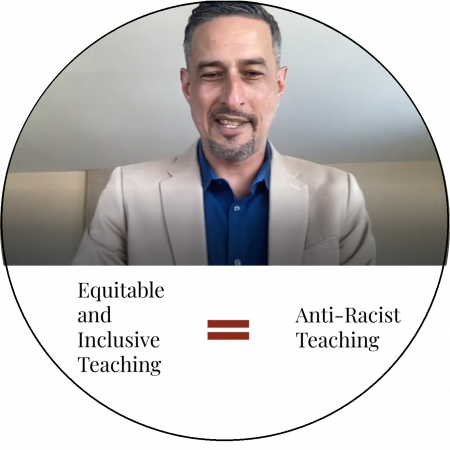Guiding voice: Jeff Camarillo, Associate Director of STEP (Stanford Teacher Education Program)
Facilitators: Josh Weiss, GSE Director of Digital Learning Solutions; Eric Abrams, GSE Chief Inclusion Officer; Emily Schell, GSE Teaching Fellow, and Fourth Year DAPS Doctoral Student
Presentation slides: TA Toolkit Session #2 Slides
Recording of the session:
Key quotes:
Think about how are you lifting marginalized cultures and voices and untold histories and narratives in your class, regardless of the subject matter or theme of your course. How are you leveraging the diversity of your classroom community to bring forth representation in your space? (17:26)
We have to be the ones to act, to shield, and protect our communities from these subtle — and sometimes not-so-subtle — forms of racism that may emerge in our classroom spaces, and that is critically important work. (21:04)
In our class, we give our graduate students an opportunity to complete an exit ticket in a Google Form that really allows them to share how they are experiencing our classroom, our community, and our teaching. (23:18)
Create more representation around culture, identity, and history in our spaces. One of the things we’re doing at STEP is what we call “cultural shares”… We’ve created an on-ramp by leveraging the heritage and history months to hold space in our seminar for students to share about their cultures, identities, and traditions. (34:33)
We are trying to find ways to connect with other programs at the GSE to think about cultural and historically themed talks and workshops… I would encourage you to think about how you can integrate [culturally and historically themed talks and workshops] themes into your program or school, wherever you’re teaching or working at Stanford. (38:08)
Take-aways:
Vigilant self-awareness
- As a model for students, try to be vigilant, self-aware, and metacognitive. Consider being transparent and visible so that students can think about what this means for themselves as they get ready to enter into the field as reflective practitioners.
- Acknowledge mistakes in one’s teaching practice and model what learning and growth looks like from those mistakes, as anti-racist teaching is a life-long journey.
- Give students an opportunity to complete an exit ticket (e.g, via a Google form) to share how they are experiencing the classroom, community, and teaching.
- Unpack feedback with the teaching team. Analyze the data and what it means to iterate towards equitable practices.
- Value the experience of all of our students and center on the experience of BIPOC (black, Indigenous and people of color) students and what they are experiencing.
Representative history
- Consider what it means to train and prepare teachers for studying and teaching representative history that is applicable to all spaces. For example, start class with a land and labor acknowledgement to acknowledge that Stanford is built on indigenous land, and that Stanford was built and financed by labor from predominantly Chinese and immigrant laborers.
- Students hold tremendous vibrancy around their cultures and lived experiences. Lift that up as a starting point to create more representation around culture, identity, and history in our spaces.
- Utilize heritage and history months to hold space during class sessions and to give students who represent the celebrated identity an opportunity to share.
- Leverage relationships and trust, and engage in that two-way conversation. Ask students what they think their history and culture should look like.
Cultural shares
- Consider how we can honor the diversity of identities in the class via engaging diverse scholarship at every point in the curriculum, and not just limited to a given day or week. Regularly integrate culturally themed readings or assignments.
- Take 15 minutes out of class to provide affirmation for students to learn about the vibrancy of each culture present.
- Consider family lineage through examining one’s own history, as well as talking about immigration patterns for broader historical context. Share family traditions, rituals, and narratives of each culture. Engaging in food and cultural practices.
